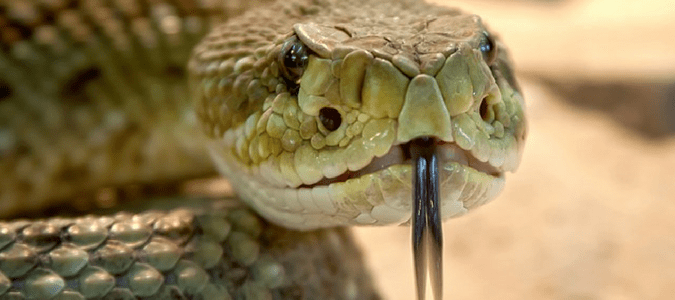Snakes.
If the very word sends shivers down your spine and makes you recoil in fear, you aren’t alone. Snakes in Texas are as ubiquitous as cowboy hats, horses and prickly pear cactuses—which is to say, you may not see them in urban areas on a daily basis but get even just a little bit rural and they’re sure to start popping up (or slithering along). While newcomers to Houston or any other Texas metropolis may not expect to deal with wildlife, snakes in Houston—and the rest of the state—are a simple fact of life. That’s why it’s so important to educate yourself about this much-maligned and often misunderstood animal.
Snakes in Texas
The two broad categories of snakes are venomous and non-venomous. Texas is home to a wide variety of species within those two groups, including many that present little or no threat to humans. Of course, plenty of snakes that are non-venomous do bite humans when frightened or provoked, so all varieties are still best avoided.
Common Non-Venomous Snakes in Texas
These are the snakes that you are most likely to see:
- Eastern hognose — These snakes are mostly harmless to humans, as they rarely bite. Typically brown and blotchy, hognoses grow to nearly three feet in length and have thick heads and upturned noses.
- Garter snakes — This smaller-sized snake grows to about two feet in length, and has a light yellow-green stripe down its back.
- King snakes — Black or black and brown in color, king snakes tend to grow to about three feet in length, though some may be longer. They often hide out in tall grasses or under logs or piles of debris. King snakes often bite when picked up or handled.
- Rat snakes — With brown or black patches on a lighter background, these large snakes look intimidating—they can grow up to six feet long! While they do bite, their bites often don’t puncture the skin. Rat snakes are excellent climbers and may be found in attics or other elevated places.
- Water snakes are also prevalent in Texas, including Houston with its extensive bayou system.
- Ribbon snakes have light-yellow stripes down their backs and grow to just under three feet in length.
- Diamondback water snakes are tan with black blotches and grow to two or three feet in length. These water snakes do bite when handled.
Venomous Snakes in Texas
Did you know that the United States is home to four species of venomous snakes—rattlesnakes, coral snakes, copperheads and cottonmouths—and all four live in Texas? In fact, Houston alone is home to all of these varieties of venomous slitherers! Fortunately, not all of these species are common, which helps to minimize one’s chances of a serious (potentially deadly) snake encounter.
Rattlesnakes are arguably the most iconic snakes in Texas, thanks to their infamous rattling tails and potentially deadly bites. Light brown with darker brown or tan splotches, rattlesnakes typically grow to two to four feet in length. Despite their fame, however, rattlers aren’t common in Houston, and they actually aren’t the most venomous snakes in Texas.
That distinction goes to the Texas coral snake, a red-and-yellow-striped species that grows to about two feet in length. Since coral snakes hide in rocky crevices or nestled in plant litter, they might be encountered in parks or woods or along nature trails. They can be dangerous not just to humans but also to dogs and other animals rooting through the underbrush. Fortunately, they are not aggressive, and typically bite only when provoked.
Copperheads are also venomous, but their poison is thought to be less toxic than that of other venomous snakes—though a copperhead bite could result in the loss of a finger, toe or even a limb. Tan or light brown in color with darker, coppery splotches across their backs, copperheads grow to about three feet in length and are common in many parts of Texas, including the greater Houston area.
Cottonmouths, the fourth variety of venomous snake in Texas, are also commonly referred to as water moccasins. These dark-brown or black water snakes typically grow to two to three feet in length and aren’t found only in the water; they can also be found on land or even in trees. Cottonmouths have a reputation for being aggressive toward humans and quick to bite, but like most other species of snake, they fear humans and make it a point to stay out of their way.
Protecting Yourself (and Children and Pets) from Venomous Snakes
What’s the best way to deal with snakes? Steer clear! When you come across one, don’t try to pick it up, handle it or keep it as a pet. To keep your outdoor living areas snake-free, keep your grass cut short and your yard clear of underbrush. Don’t let piles of leaves, sticks, branches, logs or boards accumulate, as these provide an attractive nest for many snake varieties. When you’re hiking or working outdoors, especially in tall grass or near piles of brush, wear long pants and thick boots to protect yourself in case you surprise a snake in its habitat.
Why Snakes Are Good to Have Around (Yes, They Really Are!)
Even if snakes make your skin crawl, it’s important to remember they are an important part of the food chain and environment. They help keep rats, garden slugs, grasshoppers and other pests—including other snakes—at bay. And the vast majority of snakes are not aggressive when they are left alone.
ABC Home & Commercial Services has been in the pest control business for over 60 years. As the largest independently-owned and operated pest control company in the state, we’ve come across many different types of wildlife that homeowners want off their property. If you want to get rid of rodents and other common types of wildlife, you can count on our highly trained, experienced pest control technicians to get the job done right.
